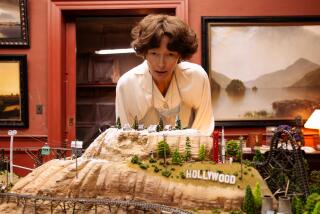Review: Director Werner Herzog risked his life for the thrilling volcano documentary ‘Into the Inferno’
- Share via
In 1976, Werner Herzog visited the small town of Basse-Terre on the island of Guadeloupe, from which thousands of residents had been evacuated after warnings of an impending volcanic eruption. The 30-minute documentary that emerged, “La Soufrière,” focused not on the volcano itself (which didn’t erupt after all), but rather on a lone farmer — a classic Herzogian human enigma — who insisted on staying behind, calmly resigning himself to death.
We see a few scenes from “La Soufrière” in Herzog’s transporting new documentary, “Into the Inferno,” a feature-length companion piece that is very much focused on volcanoes — on the majestic, terrifying poetry of blazing lava flows and smoking craters, their eruptions accompanied on the soundtrack by operatic blasts of Verdi, Schütz and Rachmaninoff.
No stranger, at 74, to the most far-flung danger zones the world has to offer, Herzog here seeks out hot spots in Vanuatu, Indonesia, Ethiopia, Iceland and North Korea, and invariably uncovers a spectacle of thrillingly cinematic sound and fury.
But even as “Into the Inferno” invites us to marvel at our insignificance in the face of Mother Nature’s seething primordial firepit, Herzog, being Herzog, refuses to lose sight of the human element. As ever, he is keenly attuned to the ways in which people affect the lands they inhabit (and vice versa), and how their precarious situations have led them to mythologize their own existence. What fascinates him here is not just a few flatulent mountains, but also the civilizations that have sprung up in their immediate vicinity, and the religious and spiritual narratives that have taken root like plants in newly fertile soil.
On the volcanic island of Ambrym, Herzog meets with the villagers of Endu, who view the lava pit as a sort of communicative spirit realm, a primordial portal between this world and the next. He finds a more scientifically advanced community in Indonesia, closely monitoring seismic activity around the always active Mt. Merapi. But even here, fascinating systems of belief emerge, as evidenced by the seaside fertility rituals performed by locals, as well as the construction of an odd, bird-shaped house of Catholic worship. (It’s meant to resemble a dove, but instead has become known as “the Chicken Church.”)
Herzog’s fellow guide in this endeavor is the British volcanologist Clive Oppenheimer, whose book “Eruptions That Shook the World” is credited as the documentary’s inspiration. The two men met a decade earlier while Herzog was shooting his 2007 documentary, “Encounters at the End of the World”; more specifically, they met in Antarctica, on the edge of the crater of Mt. Erebus, and the footage excerpted here shows Oppenheimer sensibly teaching his companions how to dodge the occasional gusher.
Herzog and Oppenheimer themselves narrowly avoided a fiery fate near of Indonesia’s Mt. Sinabung, which at one point rained ash and lava on the very spot where their cameras had been set up just a few days earlier. “Into the Inferno” acknowledges a few of those who have been less fortunate, such as the French volcanologists Katia and Maurice Krafft, who were wiped out by a pyroclastic flow on Japan’s Mt. Unzen in 1991.
But for the most part, the movie is less concerned with individual casualties than with the indelible marks that these volcanoes have left on history — geologically, geographically, culturally. Herzog’s filmography has, until now, offered as varied and astonishing a catalog of natural phenomena as you could hope for. But on a level both visceral and abstract, he seems deeply enthralled by the volcano in its boundless capacity to create and destroy, its impact on not just the ground beneath our feet but also the very atmosphere we breathe.
Herzog meanders a bit too long in the stiflingly hot Afar region of Ethiopia, where an animated UC Berkeley professor and a skilled local fossil hunter dig for the remains of early humans who dwelt in the shadow of a nearby volcano. A very different relic is Iceland’s Codex Regius, an ancient, weathered text that includes an apocalyptic account of the volcanic activity that has shaped this country for centuries.
In the documentary’s most surreal interlude, Herzog and Oppenheimer are invited to film a volcano research program in North Korea, where the long-dormant Mount Paektu — a significant landmark in the history of Kim Il-sung’s fight for independence from Japan — has effectively been harnessed as an instrument of government propaganda. Yet Herzog surveys all his subjects with a measure of equanimity, and the people he encounters here — university students proudly singing and marching near the mountain, tour guides treating the Kim family’s log cabin with a reverence befitting the Holy of Holies — can’t help but elicit from the director a droll yet sincere curiosity.
And something more — an understanding of the human desperation that underlies the most elaborate myths, and the inevitability with which they will all eventually fade away, his own included. “The soil we are walking on is not permanent,” Herzog murmurs. “There is no permanence to what we are doing.” And yet still he labors on, forever in search of his next frontier.
------------
‘Into the Inferno’
Not rated
Running time: 1 hour, 47 minutes
Playing: Laemmle’s Playhouse 7, Pasadena
See the most-read stories in Entertainment this hour »
Movie Trailers
More to Read
Only good movies
Get the Indie Focus newsletter, Mark Olsen's weekly guide to the world of cinema.
You may occasionally receive promotional content from the Los Angeles Times.











